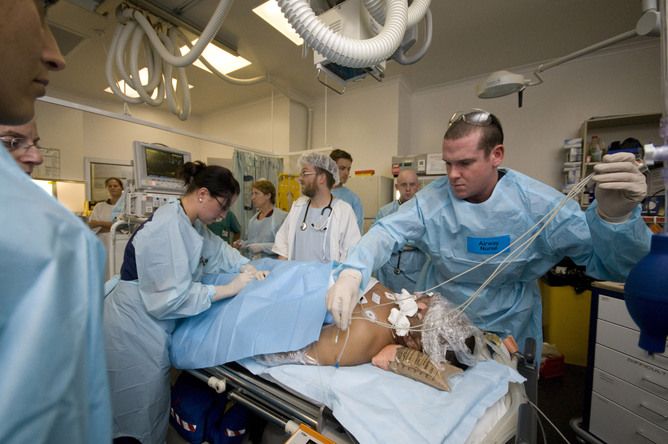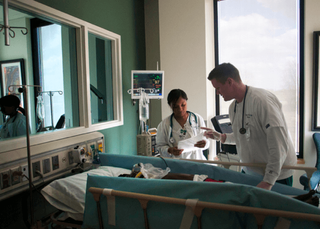
Rapid Response Teams Halve Hospital Heart Attack Deaths

This article was originally published at The Conversation. The publication contributed the article to Live Science's Expert Voices: Op-Ed & Insights.
Detecting and treating patients before they have a cardiac arrest isn’t rocket science, but it’s a life saver.
Rapid response systems identify deteriorating patients by abnormal vital signs and observations such as low blood pressure and high breathing rates. As soon as the patient is identified, there is a rapid response by staff experienced in caring for the seriously ill. The right person attends the right patient at the right time.
Research my colleagues and I published in the Medical Journal of Australia shows the scheme has reduced cardiac arrests and deaths associated with cardiac arrests in hospitals by about 50%. Nationwide, this saves around 12,000 lives per year.
The system was first developed in Sydney, Australia in 1990 and the proportion of NSW hospitals with rapid response teams more than doubled between 2002 and 2009, to 74%. Response teams now operate in most Australian hospitals, with slight variations.
So why did it take more than two decades to achieve such coverage? It comes down to the rigid ways in which hospitals historically operate.
An ageing system
Hospitals are the self-proclaimed flagships of medicine. That is where the majority of our health budget is spent and where technological advances have been made.
Sign up for the Live Science daily newsletter now
Get the world’s most fascinating discoveries delivered straight to your inbox.
Hospitals have machines to support or replace most organs in the body; incredible advances in surgical procedures; amazing diagnostic tools; and the increasing use of interventional radiology to perform procedures such as stopping internal bleeding and opening up blocked blood vessels.
Ironically, all of these impressive developments are practised within a system which has not changed in more than a hundred years. Patients are admitted “under” a specialist doctor, who usually work with a team of trainee doctors. One senior doctor is ultimately responsible for the performance of their team and for the care of the patient.

This has advantages over the patient being cared for by a committee or administrator. But it has obvious disadvantages. Most hospitalised patients are now older with a whole range of age-related problems. They are more vulnerable and, at the same time, having complex interventions with high rates of complications.
The “sick elderly” now comprise the majority of those in hospitals. They no longer neatly fit into one organ related speciality and are frail and at risk of deterioration.
Increased medical specialisation means that the deteriorating patient is often not recognised. Even if they were, the admitting team have become so specialised they no longer have all the skills and experience necessary to treat complex patients who are seriously ill.
A better way to prevent heart attacks
Before rapid response systems, a nurse would record abnormal vital signs such as a low blood pressure or high pulse rate but they were not empowered to act. They would seek the advice of the most junior member of the admitting team who usually did not have the experience to manage such complex patients.
The junior staff member would refer up the hierarchy, perhaps eventually to the admitting specialist whose expertise was not in acute resuscitation. So many patients had potentially preventable cardiac arrests or deaths. In other words, unwritten and embedded codes of practice would often trump patient care.
Rapid response systems now empower nurses at the bedside to bypass the rigid hierarchy and to advocate for the patient by immediately summoning for urgent assistance by a team trained in the management of seriously ill patients.
Admitting specialists have always been happy to have a cardiac arrest team attend their patients after the patient’s heart had stopped. But about 80% of cardiac arrests in hospital occurred after a slow and predictable deterioration over at least eight hours. Even knowing this, there was initial resistance to having other specialists attending their patients apart from when they had a cardiac arrest.

This resistance slowly disappeared and then another challenge emerged. The bedside nurses and the admitting medical team were so convinced that a rapid response system acted in their patient’s interest, that the rate of calls increased to levels that were difficult for staff to sustain. The extra workload was a strain on intensive care resources who were often already overworked and under-resourced.
There were also a minority of intensive care specialists who were reluctant to provide care outside of their own unit, despite patients in other wards being equally as ill as their own patients.
Most intensive specialists came to realise that all patients in a hospital are much more at risk than what they used to be and that it is often random whether a seriously ill patient is within the intensive care unit or in a general ward. In fact, the patients who are subject to a rapid response call are often more seriously ill than those in intensive care.
Towards patient-centred care
Rapid response teams are one of the first organisation-wide systems that has been constructed around the needs of a patient rather than geographical or professional silos. This may change the way we establish health systems. It’s hard to go wrong if you construct a system around the needs of a patient.
We’re now investigating how such a system might better respond to the needs of patients at the end of their life. More than one-third of all rapid response calls are for patients at the end of life. This means that hospitals find it difficult to recognise patients who may be dying.
It’s important that we put into place more accurate ways of identifying patients at the end of life, even if it only means that we honestly explain the poor prognosis so that patients and their carers are able to plan their lives.
Just like rapid response systems, once the patient is identified as having a poor prognosis the response could be more appropriate than simply admitting the patient to an acute hospital. Patients and their carers could then be made aware of all the various options that are available so that they can make an informed choice.
Kenneth Hillman does not work for, consult to, own shares in or receive funding from any company or organisation that would benefit from this article, and has no relevant affiliations.
This article was originally published on The Conversation. Read the original article. Follow all of the Expert Voices issues and debates — and become part of the discussion — on Facebook, Twitter and Google +. The views expressed are those of the author and do not necessarily reflect the views of the publisher. This version of the article was originally published on Live Science.











